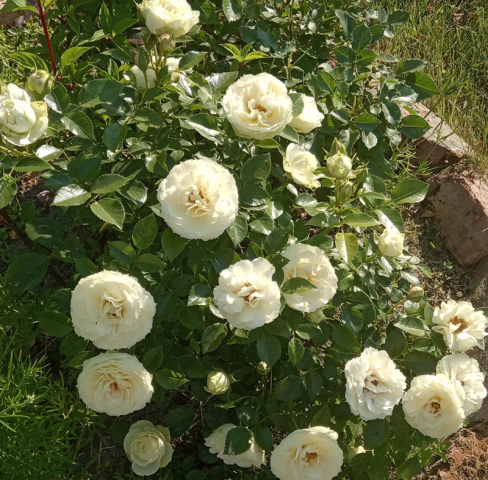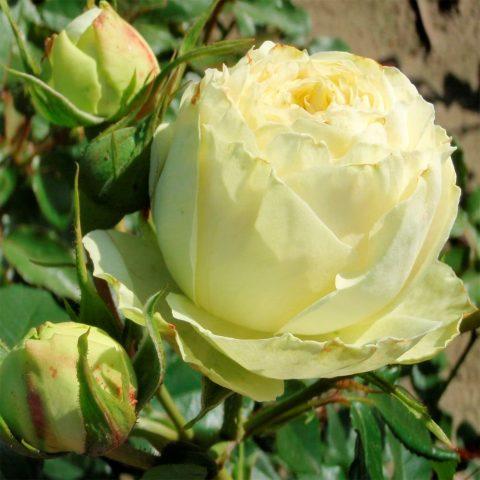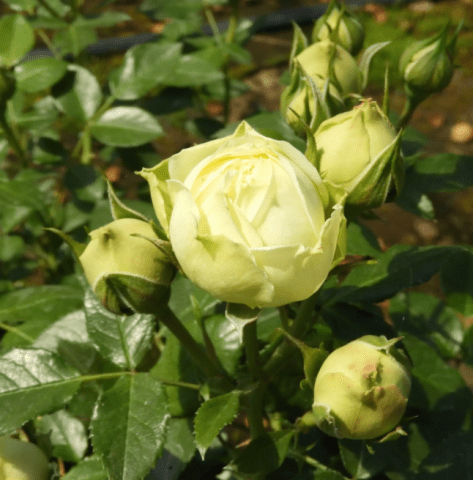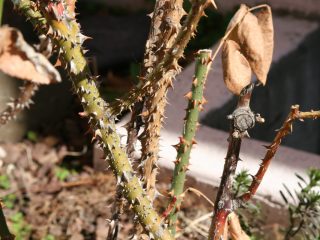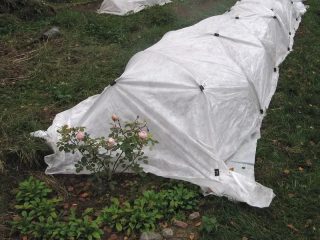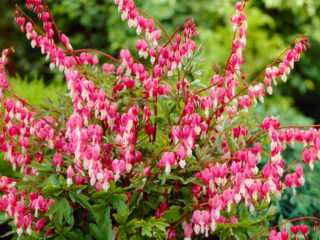Content
Rose Lemon Rococo is a very interesting variety obtained in 2016. Produces small inflorescences of a classic shape, lemon color, with shades of pale green. Flowers look beautiful both in the garden and in bouquets. Basic recommendations for planting and care are described in the article.
Origin story
Rose Lemon Rococo is a floribunda and was bred in 2016 in Tantau. This is the name of one of the famous German nurseries operating in northern Germany. It was founded in 1906 by Matthias Tantau. Over several decades, breeders based on this organization managed to develop quite a few different varieties, including Lemon Rococo.
Seedlings from Tantau are of good quality; they take root in different soils. Moreover, all varieties of roses, including Lemon Rococo, are resistant to adverse weather conditions, including frost, temperature changes and drought. Another advantage is early flowering and immunity to diseases.
Lemon Rococo is a new variety, so it has not yet been included in the register of breeding achievements of the Russian Federation. However, the variety has already begun to spread in gardens, and professional flower growers and amateurs have managed to appreciate it.
Description and characteristics of the Lemon Rococo rose
This variety of rose produces beautiful, compact bushes from 70 to 100 cm in height. The shoots are erect and do not spread to the sides, making the bush look very dense. The crown width reaches only 50 cm, which saves space. The leaves are medium sized, shine in the sun, dark green in color. Veins and edges with ribbed edging are clearly visible on the surface of the plate.
The dimensions of the Lemon Rococo scrub rose flower are small and are 6-8 cm in diameter. The shape is classic and elegant. The petals are mostly cream in color, but there are also shades of greenish. At the same time, the coloring is without sharp transitions, without variegation or a two-color background. The flowers of the rose Lemon Rococo are densely double, consist of 41 petals, arranged in several rows. 3-5 inflorescences are formed on each stem.
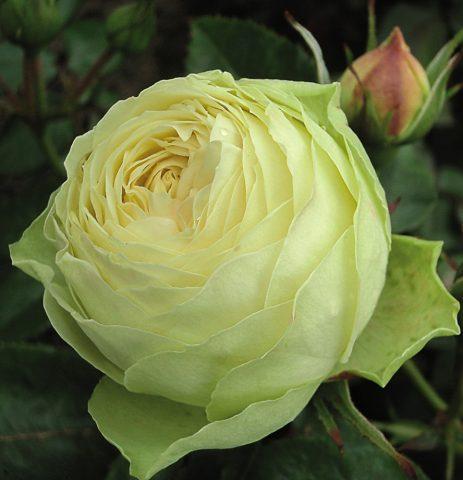
Classic shaped flowers
Rose Lemon Rococo blooms for a long time, in two waves - in June-July and July-August. If planted in a sunny location and cared for well, flowering will be abundant. Flowers decorate the garden and are used to make bouquets. However, they do not provide an intense aroma.
Rose Lemon Rococo has very good resistance to rain. The flowers open even in cloudy weather and do not lose their shape during precipitation. Another advantage is good immunity to powdery mildew. Resistance to black spot is slightly lower, but still quite satisfactory.
Advantages and disadvantages
Rose Lemon Rococo scrub has a very interesting and rather rare cream color with a greenish tint.The coloring is discreet, but very delicate and attractive. The bushes are demanding in terms of growing conditions, but they produce a lot of flowers, and in two waves.
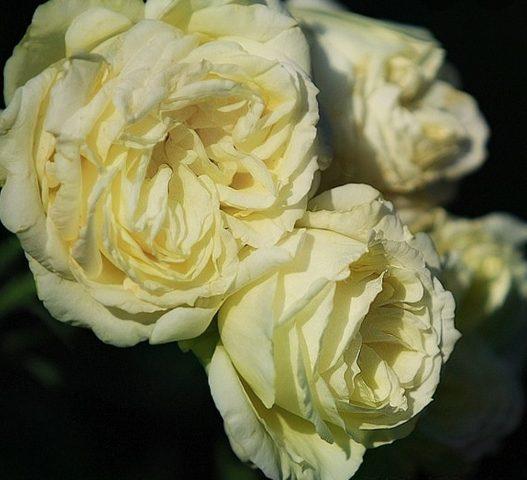
3-5 buds appear on the shoots
Pros:
- flowers of unusual colors;
- long flowering;
- resistance to diseases and rain.
Minuses:
- low winter hardiness;
- the bush requires good care;
- blooms normally only on fertile soils;
- the aroma is weak.
Recommendations for cultivation
Lemon Rococo rose bushes can only be planted in a well-lit place with fertile and loose soil, preferably on loam or sandy loam. The reaction should be slightly acidic or neutral pH = 6-7. When choosing a location, you should exclude lowlands to prevent stagnation of moisture and rotting of the roots.
It is better to plan the planting of the Lemon Rococo rose in April, although in the south you can also choose the autumn period (October). The soil is prepared in advance. They dig it up and apply fertilizer. You can add humus or compost in the amount of 8-10 kg per 1 m2 or apply complex mineral fertilizer 40-50 g to the same area. If the soil is too dense, add sand or sawdust 3-5 kg per square meter.
When planting Lemon Rococo roses, proceed as follows:
- Dig several holes 50x50 cm at a distance of at least 50 cm.
- Lay a layer of small stones.
- If the root system is open, the lower part of the Lemon Rococo bush is soaked in a growth stimulator for several hours. You can choose, for example, Epin or another drug.
- Next, they are planted in the center and sprinkled with soil.
- Tamp down a little to deepen the root collar by 3 cm.
- Water with warm water and mulch.
Since the Lemon Rococo rose is demanding of care, the plant needs to be watered regularly, especially during drought.It is necessary to focus on the condition of the soil, avoiding severe drying out and at the same time not over-moistening it. Usually water is given once a week, and in hot weather - twice.
To keep the soil moist longer, you should mulch it with sawdust, peat, pine needles or other materials. The soil is loosened periodically, especially after watering and rains.
For good flowering of the Lemon Rococo rose, fertilizing must be done regularly. In the first half of April, give urea or saltpeter (15-20 g per 10 l), and during the formation of buds - superphosphate (40 g) and potassium salt (25 g). It is recommended to apply the same composition 2-3 more times with an interval of three weeks.

The Lemon Rococo variety produces many flowers, subject to regular feeding and watering
The rose does not need too much pruning, since the bush is compact and grows quite normally. In the spring, before sap flow begins, it is necessary to remove dry and broken shoots of Lemon Rococo that have suffered from winter frosts. And in the fall, in preparation for winter (during leaf fall), all stems should be shortened by a third.
For the winter, you should also remove all foliage from the Lemon Rococo rose bush and treat it with Bordeaux mixture or other fungicides. Plant debris is removed as far as possible to prevent infection and overwintering of insect larvae. Next, you need to dig up the bush, mulch the tree trunk circle with sawdust, hay, pine needles or other materials.
The shoots of the Lemon Rococo rose are twisted and tied with rope (wires cannot be used). Then they are fixed, laid on the surface and covered with spruce branches. You can additionally insulate the top with agrofibre, and when snow falls, sprinkle it with it. The shelter is removed from the end of March to the beginning of April, and it should be removed gradually.On the one hand, the rose should not freeze, but on the other hand, it must be prevented from overheating.
Reproduction methods
The main method of propagating the Lemon Rococo rose is cuttings. To do this, you can use both flowering and wilting shoots. They are cut in mid-July. Each cutting should have two internodes - an approximate length of 15 cm.
Then proceed like this:
- Remove the lower leaves.
- The upper foliage is shortened in half.
- Make an oblique lower and straight upper cut.
- Place overnight in a solution of Kornevin or another growth stimulant.
- Then they are planted in fertile soil, for example, in a mixture of turf soil, peat, sand and humus in a ratio of 2:1:1:1.
- Thoroughly moisten and cover with a transparent jar.
- Continue to periodically water and ventilate.
- After two months, they are transferred to a permanent place and carefully covered for the winter with mulch and agrofibre.

Cuttings for propagation are prepared in July
You can try to propagate the Lemon Rococo rose by dividing the bush. To do this, in the spring, an adult bush is dug up, cut into several sections and transferred to a new place. In the first year, care should be especially thorough - periodic feeding, watering, shelter for the winter.
Diseases and pests
Rose Lemon Rococo demonstrates good resistance to various diseases and pests. It is rarely affected by powdery mildew and black spot. But it can suffer from other fungal infections, especially against the background of excessive watering.
For prevention in the spring, it is recommended to treat with any systemic fungicide:
- "HOM";
- "Ridomil Gold";
- "Fundazol";
- "Maksim".
In summer, the Lemon Rococo rose may suffer from an invasion of pests, including spider mites, aphids, and leaf rollers. To cope with them, it is recommended to treat with insecticides:
- "Karbofos";
- "Aktara";
- "Biotlin";
- "Vertimek".
Spraying of bushes is planned in cloudy weather, it is advisable to do this in the late evening or early morning. Moreover, there should be no rain or strong wind outside.
Application in landscape design
Lemon Rococo rose bushes are quite compact, so they look beautiful in group plantings. For example, you can make a beautiful alley along the path next to the house. Single plantings are appropriate near the home, against the backdrop of a lawn, near a bench, on the shore of a pond.
Below are some interesting ways to use the Lemon Rococo rose in garden design:
- Landing in an open area.
- Single occupancy.
- Another option for solitaire planting.
Conclusion
Rose Lemon Rococo is quite demanding in terms of care, but even a novice gardener can cope with its cultivation. The bush is compact, and the color of the flowers is very delicate, suitable for lovers of lemon shades. If you regularly water and feed, flowering will be abundant until the end of August.
Reviews of rose Lemon Rococo
